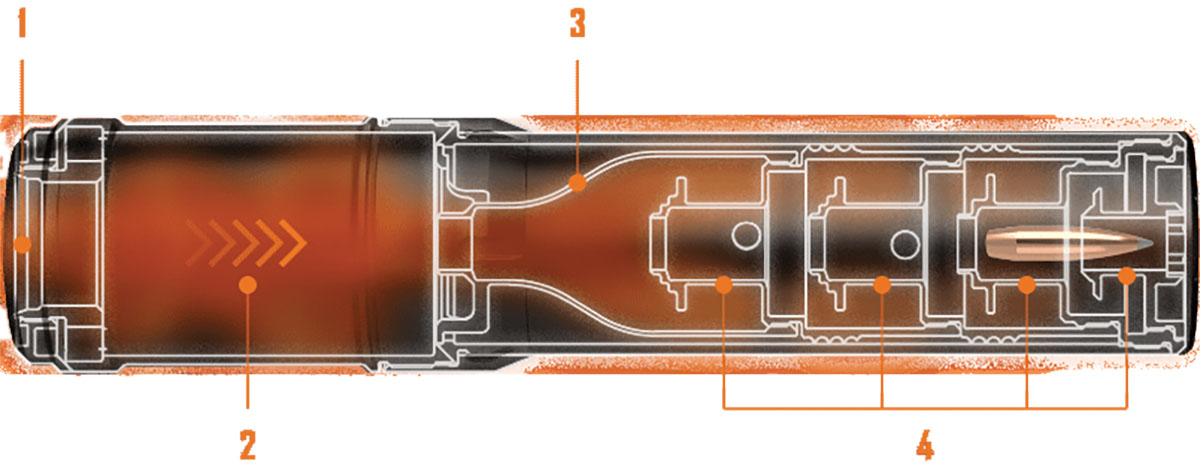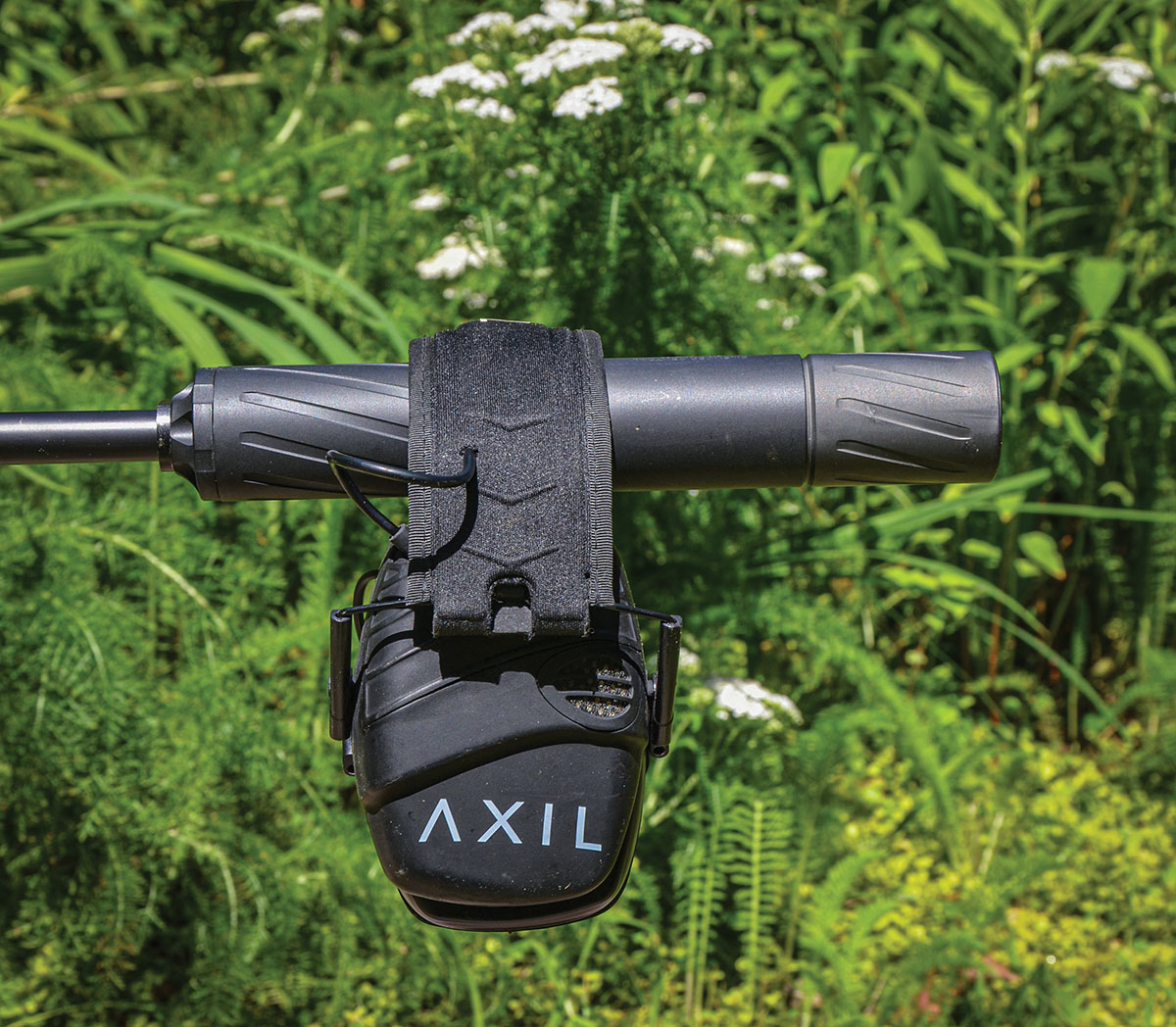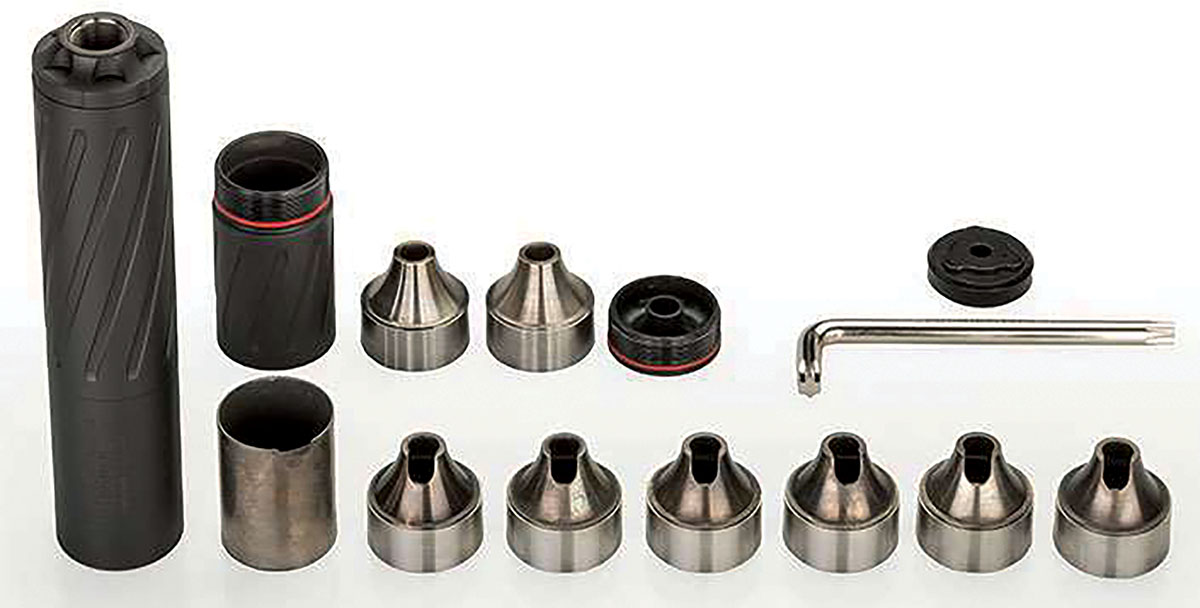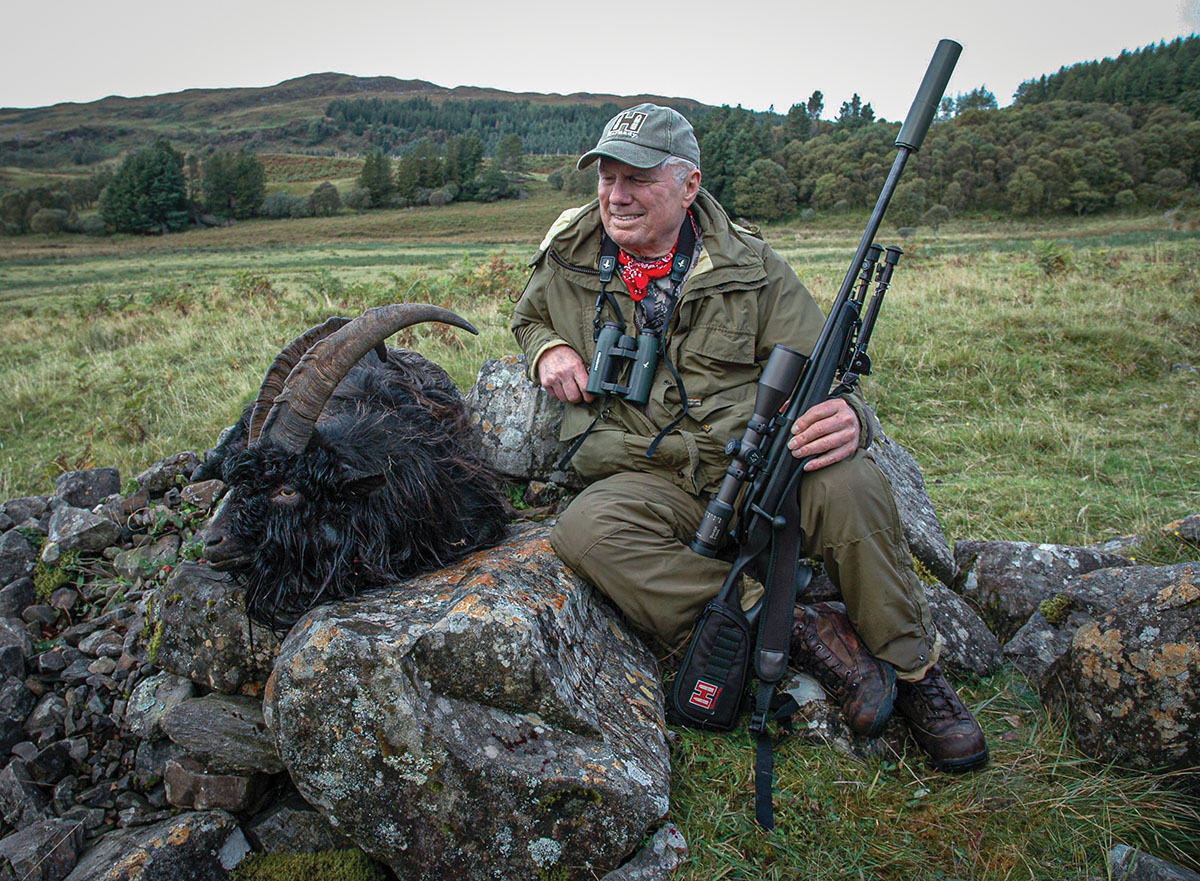
A suppressor adds length to a rifle so choosing a shorter rifle is a popular fix. Wearing a suppressor measuring seven inches long, a Howa Model 1500 Superlite with a 20-inch barrel in 7mm-08 Remington (right) alongside a Remington Model 700 SS with a 26-inch barrel in 300 Ultra Magnum with no suppressor (left).
Born in America in 1840, Sir Hiram Stevens Maxim became famous for developing a machine gun, described by him as so terrible and frightening it would surely prevent any country in the world from declaring war on another. His son, Hiram Percy Maxim, mechanical engineer and inventor, later silenced that gun and others like it. In 1899, Percy won the first-closed circuit race driving an automobile with a noisy internal combustion engine. He silenced it, too, and received a patent for his automotive muffling device.

A rifle kept on hand for home defense is an excellent candidate for suppressor wear. This Ruger Mini-30 in 300 BLK with its magazine filled with Hornady or Lehigh Defense Sub-X subsonic ammunition is an example. It also works nicely for taking coyotes called in close in settled areas where muzzle blast can be objectionable to residents.

Hiram P. Maxim firing a Hotchkiss M1909 Benet-Mercie machine rifle with his silencer attached to its barrel. The gun was briefly adopted by a number of countries, including the United States, where they were built in 30-06 at Springfield Armory and Colt’s Manufacturing Coompany. (Photo courtesy of Small Arms Review.)
While the U.S. Army and various other military powers became interested in Maxim’s sound suppressor, he had actually designed it to be used by hunters and recreational shooters. In his booklet, “Experiences with the Maxim Silencer,” published in 1915, he mentions his love of shooting various firearms and a personal desire to do so without disturbing his neighbors. Far more important than eliminating neighborhood complaints was the fact that his silencers greatly reduced shooter hearing loss. The book also contains testimonials from hunters and other sportsmen who were using his invention with great satisfaction. Perhaps his most famous customer was Teddy Roosevelt, whose Winchester 94 in 30-30, or “little 30” as he called it, wore a Maxim silencer. Advertisements in
Sporting Goods Journal and various other publications informed one and all that a shop in Hartford, Connecticut. owned by Maxim sold his silencers by mail order. Prices were $7.50 for the 22 Rimfire version and $10.50 for one promoted as “For the Savage 22 Hi-Power and other rifles up to .32 caliber.” Removing a threaded end cap from the tube of the silencer allowed its baffles to be removed for cleaning.
Then, in 1934, the U.S. Government made the decision to treat millions of honest, law-abiding citizens the same as professional gangsters such as John Dillinger and Clyde Barrow by introducing the National Firearms Act. It did not actually ban ownership of silencers and fully-automatic firearms. The required $200 tax stamp was not a problem for good old John, Clyde, Baby Face and others of their ilk – they either ignored the law entirely or just went out and robbed another bank to get the money. At the time, the cost of the tax stamp represented about 11 weeks of pay for most working citizens. That, along with the mountain of required paperwork, pretty much doomed the use of silencers by all but a few Americans.

In addition to advertising in various American hunting and shooting publications, a shop in Hartford, Connecticut owned by Maxim, sold his silencers by mail order. Prices were $7.50 for the 22 Rimfire version and $10.50 for one promoted as “Ideal for the Savage 22 Hi-Power and other rifles up to .32 caliber.”
The tax stamp is still $200, but today, it represents the cost of four boxes of Berger 6.5 Creedmoor ammo. The devices can now be legally purchased by American citizens residing in 42 states and hunters in all but two of those states are allowed to use them for taking game. Getting the wheels of progress rolling toward eventually owning a suppressor is easily accomplished by visiting a firearms dealer who has the appropriate licenses. Those who sell suppressors used to be few and far between, but the demand is so great today that there are probably far more gun stores across the country that do sell them than do not. Eight stores within a 25-mile drive of our home not only sell suppressors, but each has a variety of brands and models in stock. Like firearms, each suppressor is serial numbered by the company that made it.

A Winchester Model 94 in 30-30, fondly described by Teddy Roosevelt as “little 30,” wore a Maxim silencer.
Services offered can vary among gun stores. My Nosler suppressors were acquired from a local dealer who stored them in his safe while I awaited ATF approval. On that first visit, the dealer took a digital passport-size photo of me and followed with two sets of fingerprints. We then sat before his computer and digitally sent the photo, my credit card info (for the $200 tax stamp) and all other required personal information to the ATF (he mailed the two fingerprint cards). The entire approval application process took about 45 minutes, and I was on my way. Rather than doing the fingerprinting, some dealers speed up the process by sending them digitally. Another sends his customers to the local law enforcement center where the charge is $12 for the required two sets of prints. As I said, services rendered by various dealers can vary.

This cutaway rendering of a Nosler suppressor illustrates how it works and consists of the following parts: (1) Rear cap, (2) Blast (expansion) chamber, (3) Blast baffle and (4) Three secondary baffles. Super-heated propellant gas begins to cool and slow as it flows in and around the baffles. This cooling effect is illustrated by the fading of the red coloration (which represents propellant gas) as it nears the muzzle of the suppressor. A bullet is shown just prior to its exit from the suppressor. The suppressor can be attached directly to the barrel of a rifle or over a Nosler titanium muzzle brake attached to the barrel. Interior designs vary considerably among the various manufacturers of suppressors, but the concept remains the same.

The fact that the suppressor and muffs shown here have the same sound reduction rating is deceiving. The suppressor never changes while age and wear along with how the muff is worn can drastically reduce its level of hearing protection.
There was a time when it was not uncommon for people to grow old between deciding to get a suppressor and actually owning one but due to e-Form application acceptance and other streamlining at ATF, the wait time can now be less than a lifetime, sometimes considerably less. My tax stamps arrived via e-mail 54 days after my applications were filed and I immediately made a second trip to the dealer to pick up my two suppressors. It is important to add that each suppressor purchased requires filing an application for approval by the ATF. The local gun dealer route has advantages, one being the fact that all in my area have various brands and models of suppressors in stock. Hands-on comparison and examination prior to taking the plunge can be important, not to mention the personal side if you know the dealer. Some dealers offer a no-fee payment plan during the ATF approval period.
Purchasing a suppressor online from Silencer Central is another popular option. With the exception of receiving a fingerprinting kit in the mail and returning the two cards the same way, the entire process is done digitally. A friend who lovingly describes his computer as a Fred Flintstone Signature Model found several such tasks to be beyond its capabilities. The machine allowed him to fill out various documents digitally, but it refused to allow him to sign them in that manner. With the assistance of a couple of customer service representatives, Mr. Flintstone managed to overcome those obstacles, and the road eventually became less bumpy. A suppressor was eventually delivered to his door by a Fed-X guy who, coincidentally, had purchased his suppressor from the same company. All things considered, he rates his experience with Silencer Central as a pleasant one and the smile rate among those who have more modern computers is probably even higher. Silencer Central is especially good news for those who live in the remote areas of Alaska and other places that do not have a nearby firearms dealer. Unlike most devices and other stuff we buy, a good suppressor is both trouble-free and virtually impossible to wear out.

The all-titanium Banish 30 suppressor from Silencer Central is shown here disassembled to illustrate its various parts. It is nine inches long, it has eight baffles and it weighs 14.3 ounces. When easily shortened to seven inches, as some owners do when attaching it to a hunting rifle, its weight is reduced to 11.2 ounces. Doing so reduces the number of baffles from eight to six and reduces sound mitigation rating by around 5 dB. The suppressor retains its maker’s “hearing safe” rating for a single exposure of brief duration.
While Hiram Percy Maxim described his wonderful invention as a silencer and the word is often used rather loosely today, his device only reduced or suppressed the level of sound and did not silence it entirely. (For a reason obvious to anyone who has held one in their hand, it has also long been referred to by many as a can). The basic designs of suppressors made today differ very little from those built by the Maxim Silencer Company 115 years ago and the concept is the same. As super-heated propellant gas enters the unit, baffles disrupt its flow, causing the gas to expand, cool and slow a bit prior to entering the atmosphere. All of this has no effect on bullet travel because it has already exited the suppressor and is on its way.

Attaching a suppressor to a rifle increases its weight by how much depending on which model is used. This Nosler SR-30K weighs 7 ounces, about as much as eight 308 Winchester cartridges.
As one information source aptly puts it, the decibel (dB) serves as a universal yardstick for measuring sound intensity and it captures the range of audible sound the human ear can detect. From the whisper-quiet rustle of leaves on an autumn day to the roaring blast of a jet engine during takeoff, the logarithmic scale provides a nuanced way to comprehend levels of sound. Barrel length, propellant gas volume and muzzle pressure greatly influence the level of muzzle blast but as an example, let us say that the typical factory 30-06 deer load fired in a rifle with a 22-inch barrel delivers 160 dB to the shooter’s ear. Top-quality, properly fitting muff-style protectors usually have a maximum sound reduction rating of around 25 dB which would reduce the level of sound received by the ear to 135 dB or so. As another example, the Nosler SR-30ALTi suppressor also has a sound reduction rating of 25 dB, so the two are even-Steven in the level of hearing protection they offer, right? Well, not necessarily. Whereas the sound reduction level of the suppressor never changes, aging of the muff and how it is worn can drastically reduce its effectiveness. Soft padding enclosing the ear can deteriorate with age and reduce actual sound reduction. The temples of protective eyewear as well as long hair can compromise its ability to seal off the noise.
Everything, including design, remains the same; the longer the suppressor, the more effective it is at sound reduction, and my Banish 30 from Silencer Central does a good job of illustrating that. Nine inches long, it contains eight sound-reduction baffles. Some hunters consider that to be a bit much for their rifles, so the Banish 30 is designed to be easily shortened to seven inches, during which two of its baffles are left out. Doing so reduces the sound reduction rating of the suppressor by about 10 dB although it still retains its “hearing safe” company rating for a single exposure of brief duration.
A suppressor does not mitigate the sonic boom made by a bullet as it exceeds the speed of sound but it is a small factor when compared to muzzle blast. It is also less noticeable to a shooter behind the rifle than to someone who is standing off to the side. Slowing the bullet down to subsonic velocity (usually around 1,100 fps) eliminates that sound. The ping of a bullet striking a distant steel target is much louder, as is the cycling of an AR-15. Respective velocity ratings for Hornady’s subsonic loading of the 300 Blackout with a 190-grain SUB-X bullet is 1,050, and for the 45-70 loaded with a 410-grain SUB-X, it is 1,075 fps. Lehigh Defense ammunition loaded with a-198 grain Controlled Fracturing bullet has a 1,050 fps rating from a 16-inch barrel. Those three bullets are designed to expand at impact velocity as low as 900 fps.

The scenic heather-covered hills of northern Scotland have excellent populations of red stags and feral goats. This goat was the very first game animal taken by Layne with a suppressed rifle. The rifle and the Hornady ammunition loaded with the 150-grain SST bullet belonged to his guide.
I first used a suppressed rifle while hunting red stag and feral goat among the scenic hills of northern Scotland. The rifle in 308 Winchester belonged to my guide and his Hornady ammunition was loaded with the 150-grain SST at 2,800 fps. As I was into a pre-hunt zero check with the rifle resting on my daypack, he tapped me on the shoulder and suggested that I remove my muffs and try a shot at paper. I was absolutely amazed at the light report and left the muffs in my daypack while taking my stag and goat with one shot each. As we chatted over cups of hot tea after the hunt, Malcolm remarked about the United States being advanced enough technologically to send men to the moon and back while still remaining in the Stone Age when it comes to suppressor ownership. He went on to add that he could go to the village market and buy a can of beans for dinner and a can for his rifle with no paperwork required for either. Simply pick both off the shelf, pay the clerk and take them home.
Hunters are at great risk because many don’t wear hearing protection in the field. Taking along muffs or earplugs is an effective solution if there is time to put them in place prior to taking the shot. But some shots at game come quick and there is not enough time. This is when a suppressor capable of greatly reducing the blast is worth far more than its cost. A suppressor can also open the door to some hunting opportunities where the blast of a non-suppressed rifle would not be accepted. In my part of the Deep South, calling in coyotes during daylight hours is a wasted effort, but with a bit of luck, they can be taken at night. Farms are fairly small and while most stock owners absolutely hate coyotes, they do not appreciate being disturbed by gunfire at night. A suppressed 223 will get you invited back time and again. The Hornady and Lehigh Defense subsonic loadings of the 300 BLK mentioned earlier are as quiet as a mouse scampering across a carpet and are deadly on coyotes called in close. High-volume prairie dog shooting with the 223 Remington or other high-velocity cartridge is where a suppressed rifle really pays off, and when doing so, I double-up by also wearing muffs. In fact, the only time I do not wear muffs when shooting a suppressed rifle is when hunting big game with only a shot or two anticipated. Such a pity that suppressors were not as easy to own while I was growing up. If they had been, I might still be able to enjoy the chirp of a cricket.
I will close by mentioning that a short rifle kept on hand for repelling castle invaders should wear a suppressor. A suppressed Ruger Mini-14 in 300 Blackout with its magazines filled with subsonic ammo is our favorite behind-the-door, permanent house guest.












